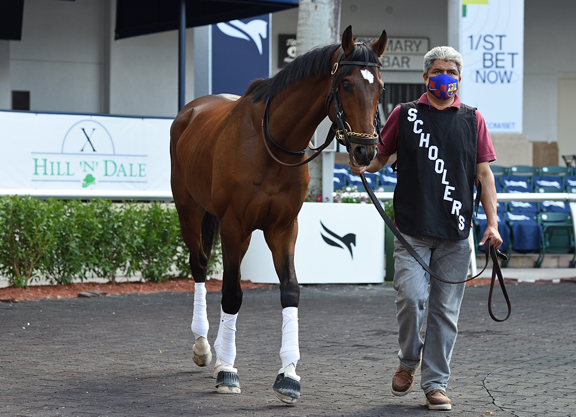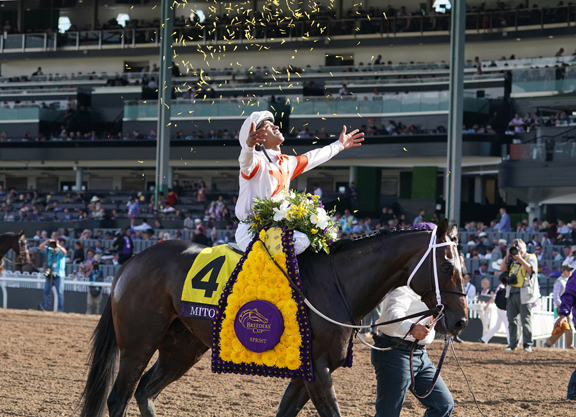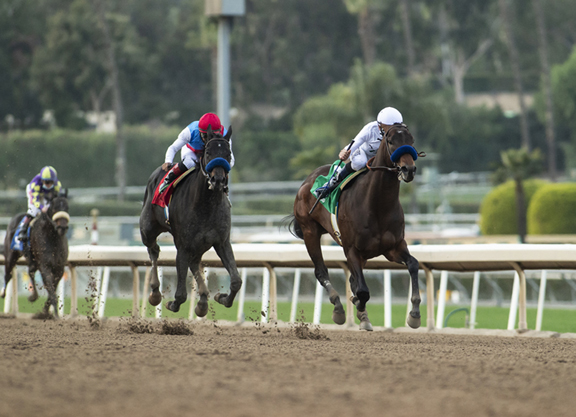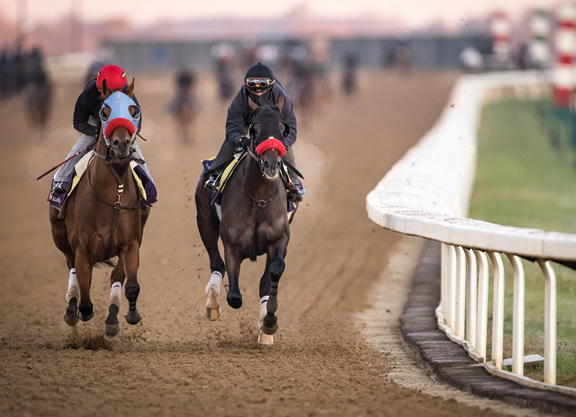For the first time in its 31-year history, Kentucky Downs is offering three $1 million races during its six-date 2021 meet. Added to the track's signature Grade 2 Calumet Turf Cup, whose purse was first raised to seven figures in 2019, Kentucky Downs' $1 million trio also will feature the Grade 3 Turf Sprint and Grade 3 WinStar Mint Million.
Kentucky Downs will stage 16 stakes worth a track-record total of $10 million, including $4.85 million in purse supplements for registered Kentucky-bred horses. The all-grass meet runs Sept. 5, 6, 8, 9, 11 and 12 over Kentucky Downs' undulating, kidney-shaped 1 5/16-mile race course.
The WinStar Mint Million, formerly the Tourist Mile, presently stands as the United States' second-richest eight-furlong grass stakes behind only the $2 million Breeders' Cup Mile (G1). The race was worth $750,000 last year, while the six-furlong Turf Sprint was $700,000.
Kentucky Downs for the first time has a pair of Grade 2 stakes in the Calumet Turf Cup for older horses at 1 1/2 miles and the Franklin-Simpson for 3-year-old sprinters, now worth $600,000.
“Purses are the economic engine of the racing industry, and Kentucky Downs is proud to be a leader helping Kentucky stamp itself as the premier racing circuit in America,” said Ron Winchell, Kentucky Downs' co-owner and managing partner with Marc Falcone. “We're only six days, but winning one of our stakes – or even one of our overnight races – can make the entire year for an owner. Many horsemen tell us that money they earn at our meet gets promptly reinvested in the industry the next week at Keeneland's September Yearling sale. Such investment impacts countless small businesses that are part of Kentucky's equine agribusiness.”
A total of nine Kentucky Downs stakes received purse hikes. That includes the Ladies Turf (Grade 3) jumping from $500,000 to $750,000. Each of Kentucky Downs' six graded stakes is worth at least $600,000, with the Grade 3 Ladies Sprint joining the Franklin-Simpson in getting $100,000 increases to reach $600,000. The Music City for 3-year-old fillies and Untapable for 2-year-old fillies, worth $400,000 in their inaugural runnings last year, now enjoy $500,000 purses.
The Kentucky Downs' stakes purses reflect contributions of up to 50 percent from the Kentucky Thoroughbred Development Fund (KTDF) for horses born in and sired by stallions in the Commonwealth. That includes the vast majority of the horses racing in Kentucky and easily the largest group running in America. The 2021 meet's Kentucky-bred stakes supplements were approved Tuesday by the Kentucky Horse Racing Commission's KTDF Advisory Committee.
“The KTDF Advisory Committee aspires to be good stewards of the funds entrusted to their approval and direction,” said Bill Landes, the long-time chair of the KTDF committee and general manager of Oldham County's Hermitage Farm. “As such we applaud Kentucky Downs proposed KTDF supplement to their 2021 stakes, allowance and maiden race program. Their program enhances the value of Kentucky-bred racehorses not only at the Kentucky Downs meet but also enhances the value of Kentucky-bred yearlings that will sell in central Kentucky following their meet.”
Horses that aren't registered Kentucky-breds still can compete in some of the most lucrative stakes in North America and beyond. For instance, the $1 million races each reflect a base purse of $550,000 for which all horses run.
The increases were possible because the Kentucky General Assembly in February passed legislation that for the first time defined pari-mutuel wagering, including Historical Horse Racing's innovative technology that allows guests to bet on previously run races in an electronic game format.
“We can't thank the Kentucky Legislature enough,” Falcone said. “We are able to offer among the highest purses in the world because they understood the importance of Historical Horse Racing and passed legislation that ensures a bright future for live horse racing and the Commonwealth's signature industry. The lawmakers' leadership and members of both parties in both chambers saw the big picture and how higher purses lead to a lot of good things happening. That includes increased jobs, economic development, enhanced tourism opportunities and more dollars to the General Fund that ultimately benefit all Kentuckians.”
The lowest stakes purse Kentucky Downs will have is $400,000 each for the Tapit Stakes and the One Dreamer for fillies and mares, both restricted for horses that have not previously won a stakes in 2021. Those races received $100,000 increases.
The condition book for Kentucky Downs' 2021 meet will be available later this month.
Kentucky Downs 2021 stakes schedule
(all stakes include KTDF* purse supplements)
All races on turf
Sunday, Sept. 5 — $500,000 Dueling Grounds Oaks, 3-year-old fillies, 1 5/16 miles; $750,000 Gun Runner Dueling Grounds Derby, 3-year-olds, 1 5/16 miles.
Monday, Sept. 6 — $500,000 Juvenile Fillies, 2-year-old fillies, mile; $500,000 Juvenile, 2-year-olds, mile; $1 million WinStar Farm Mint Million Mile (G3), 3-year-olds & up, mile.
Wednesday, Sept. 8 — $400,000 Tapit Stakes, 3-year-olds & up non-winners of a stakes in 2021, mile and 70 yards.
Thursday, Sept. 9 — $500,000 Juvenile Sprint, 2-year-olds, 6 1/2 furlongs; $400,000 One Dreamer, fillies & mares 3 years old & up non-winners of a stakes in 2021, mile and 70 yards.
Saturday, Sept. 11 — $1 million Calumet Turf Cup (G2), 3-year-olds & up, 1 1/2 miles; $600,000 Franklin-Simpson (G2), 3-year-olds, 6 1/2 furlongs; $600,000 Ladies Sprint (G3), fillies & mares 3yo & up, 6 1/2 furlongs; $750,000 Ladies Turf (G3), fillies & mares 3 years old & up, mile; $1 million Turf Sprint (G3), 3-year-olds & up, 6 furlongs.
Sunday, Sept. 12 — $500,000 Music City Stakes, 3-year-old fillies, 6 1/2 furlongs; $500,000 Ladies Marathon, fillies & mares 3 years old & up, 1 5/16 miles; $500,000 Untapable Stakes, 2-year-old fillies, 6 1/2 furlongs.
*Kentucky Thoroughbred Development Fund
The post Kentucky Downs: Three Million-Dollar Races Top 2021’s $10 Million Stakes Schedule appeared first on Horse Racing News | Paulick Report.




